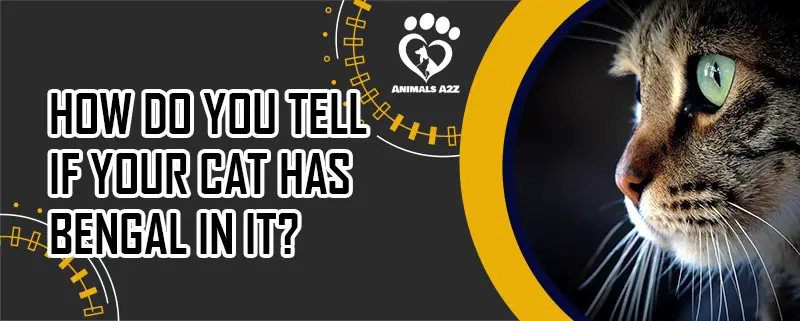Bengal cats share some similar features with other domestic cats too. In this case, it’s hard to tell if your cat is a part Bengal, especially when you don’t have pedigree papers on hand. However, Bengal cats have many distinct traits that will help you distinguish if your cat has a Bengal in it, from their “pelt” coat, lean and large body build, and outgoing personality.
Table of Contents
Bengal’s unique physical characteristics
Check the coat’s colors and markings.
One of the best identifiers if your cat is a part Bengal is its coat. The first thing you should do is check for your cat’s coat colors and markings. Bengal cats are diverse when it comes to their coat colors. Their coat may come in black, brown, silver, snow, blue, and torbie (a combination of tortoiseshell and tabby).
Bengal felines also display distinct markings and spots that give them the looks of a wild cat. They inherited the gorgeous spots from their Asian Leopard Cat ancestors. The Bengal cats have a variety of coat patterns, the spotties, marbled, and rosette. Read on and assess whether your feline friend has one of these coat patterns.
- Spotties
The spotty is the most common coat markings of Bengal. A Spotty Bengal cat has a single-tone color of spots and comes in round and random sizes that make them look like a mini-leopard cat. However, some domesticated feline breeds also show the same markings, such as Egyptian Maus, Ocicats, and Brown Spotted Manx.
- Marbled
Marbled Bengal cats display darker wiggly stripes pattern, the same pattern that can be seen in marbles. This kind of coat marking can also be seen in different cat breeds, including British Shorthairs and Manx cats.
*Sparbled*
The Bengal cats had no sparbled coat, naturally speaking. This coat pattern is a result of continuous and extensive breeding. This type of pattern displays a combination of spotted and marble Bengal cats, and you can see them with spots and swirls.
- Rosetted
Rosetted is the most articulated of all the patterns. Their coats contain spots with two colors. The marks are larger and have a beautiful contrast between the spots and the base of the coat. The rosette Bengal spots have a dark or usually black outline, with a lighter color inside. The base coat has a lighter color than the color of the spot’s inner part. Rosette pattern is a unique pattern that can only be seen on Bengals among domestic cats.
The spots are usually arrowhead in shape and are randomly distributed. This makes the Bengal cats have an asymmetrical pattern, where the markings on one side are different from the other side. This asymmetrical pattern also applies to the marbled and spotty Bengals, and these characteristics of the domestic cat’s coat are unique to this breed.
Look for pelted and glittery fur.
Experts say you can tell if a cat is a Bengal by touching with your eyes closed. This is because of the Bengal’s fabulous fur, or some often described as “pelt.” When you run your fingers through the Bengal’s coat, you should notice a satin or silky feel from their short but thick fur, which gives the Bengal’s owners impression of a “pelted” coat.
One of the most distinct and unique features of the Bengal cats is their glittery fur. They look like magical shimmering cats when sunlight strikes on their hair. This looks elegant when seen in person, but the glittering fur is hard to capture on camera.
Look for a lean and robust body.
Another distinct characteristic of Bengal cats is their lean and muscular body structure. They are categorized as medium to large size cats. Their muscle is most prominent on their limbs, neck, and shoulders.
Bengal cats have longer hind legs.
The Bengal cats have longer rear legs compared to their front legs. This allows them to run faster and jump higher than other domestic cats. They got this feature from their cat ancestors, the Asian Leopard cats.
Check for a long tail with a dark tip.
Bengal cats usually have a relatively long tail that they use for balancing while running and climbing around the house. Their tails typically have dark stripes or rings with a solid dark or black tip.
Bengal’s head shape and size
The Bengal cat’s head is somewhat small in proportion with its long and large body. Their head is triangular in shape with light chins and prominent whisker pads. The Bengal cat’s nose is larger and broader compared to other cats.
Round-shaped eyes and ears
These felines display more round shape eyes compared to the normal almond-shaped eyes of other domestic cats. The Bengal ears are small to medium in size and are round-shaped.
Identify Bengal’s distinct personality.
Bengal cats are vocal.
These cats are loud and vocal. You can tell if there’s a Bengal in a house because of their distinct voices. Bengals use different sounds- depending on what they need, to communicate with their family members.
Hunting skills
Bengal cats are intelligent cats, and they possess the hunting instincts that came from their ALC’s ancestors. You should notice this by their love of climbing and being in high places. You may see them roaming around the house looking for prey, usually mice. These cats are also fond of water and being in the water.
Bengals are dynamic cats.
Bengals have a very high level of energy. They may run and jump around for no reason, and their love for playing is exceptional.
Affectionate and friendly
Bengals are loving with their family members. They always want to have someone to play with or just be around with them. They are not aloof of strangers or new house pets, even dogs.
Common questions about Bengal cats
Can Bengal cats live with other cats?
Yes, this cat breed can be with your other feline friends under the same roof. Bengal cats are exceptionally affectionate, not only to their owners but also to other cats and house pets, including dogs. These cats can also get along well with children, but with an adult’s supervision.
Why are Bengal cats so expensive?
The price of a cat depends on the quality and rarity of the breed. In this case, Bengals are expensive because of a rarity among most of the cat breeds. They became rare because of their genetics. Bengal cat breed is a hybrid that carries the genes of Asian Leopard cats.
Why do my Bengals meow so much?
Bengal cats are very vocal. They will make a sound whenever they want to tell you something. It’s either they want to eat, play, or be petted. One of the most common reasons why Bengals meow so much is when they’re hungry or feel that their territory is being threatened.
Final thoughts
We understand that it’s not that easy to determine if your cat has Bengal in it because of many factors to be considered. This article is a checklist made just for you, to help you quickly check if your cat has a Bengal in it. Focus on the unique and distinct traits and assess if your cat possesses any of those traits.
But if still you’re having a hard time answering your question, drop everything, look at your cat friend and appreciate and embrace its uniqueness because you’re blessed with one of the fantastic felines who deserve all your love.

